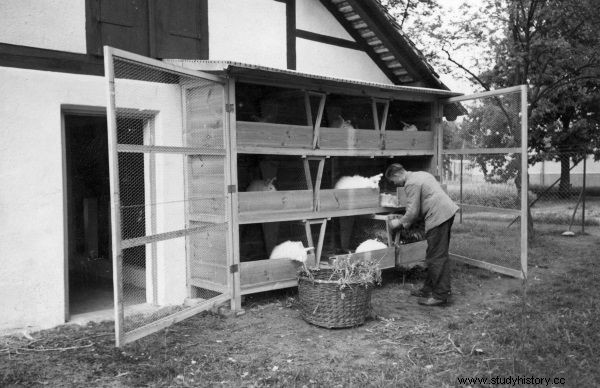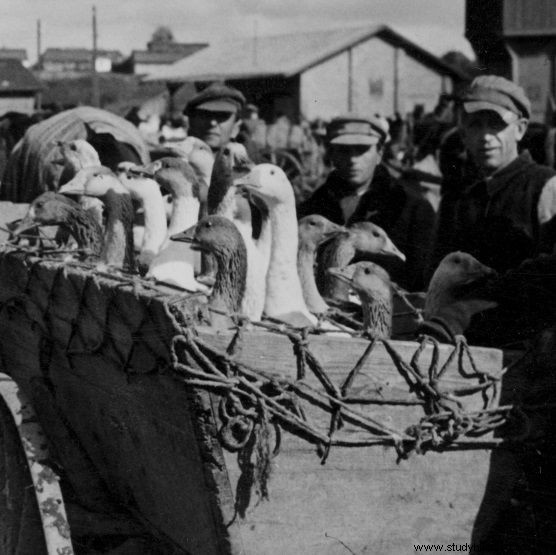During the war, the issue of food grew to the rank of a gigantic problem. In order to help at least a little, city dwellers turned empty plots of land, parks, squares and their own balconies into gardens. It wasn't that simple with home animal husbandry.
In order to secure a source of meat, people made the trouble of breeding even in city centers. Rabbits lived in basements, attics, sheds, kitchens and even bathrooms in Polish houses. Their meat is healthy, high in protein and vitamins, and the animals themselves are easy to care for and grow very quickly. These qualities made rabbits an ideal supplement to the occupation diet.
On the other hand, rabbits also had one serious drawback:they had to be fed. It was easiest to feed the animals in the summer, when fresh grass was easy to find in the middle of the city. In addition, kitchen waste and hay ended up in rabbit bellies. Winter was not without sacrifices:if the housewife wanted to keep her farm, she was often forced to deplete the supplies intended for herself and her family.
Rabbits lived most often in cages. In large cities, these cages were kept inside tenement houses. The Poznanian, Teresa Śliwińska, recalled the circumstances in which her parents decided to start their own breeding. The Germans commandeered them a stove with a copper water boiler, and even a bathtub - all allegedly as material for weapons and ammunition.
As a result, the bathroom was empty. The Śliwiński family did not intend to let the suddenly emptied area go to waste. The former bathroom was blocked up to the ceiling with rabbit cages. There was also a place for a barrel with sauerkraut and a box with garden soil, where the housewife kept vegetables

Examples of cages in which rabbits were bred. The photo comes from the book "Occupation from the kitchen" by Aleksandra Zaprutko-Janicka.
The bathroom attracted children like a magnet. Teresa Śliwińska describes how she got to know the habits of rabbits and watched them closely. This interest, combined with looking after the animals and tediously obtaining food for them (which was usually the responsibility of children) could only have one effect. The youngest members of the family became attached to small fluffy balls that landed on the plate after a few months.
It was mentioned by Maria Kwiatkowska, who was a teenager during the occupation and lived with her mother and younger brother in Sędziszów Małopolski. It was the aforementioned brother, Poluś, who took care of the flock that was to provide the family with meat. Rabbits lived in a small stable behind the house, and when they had to say goodbye to life:
Their neighbor Buś was killing them, and my mother spiced them in different ways. Poluś was distracted because he was very attached to them and he felt sorry for them when rabbits were taken to eat.
It was impossible to explain to the child that in the face of war, the welfare of animals must be of secondary importance. The best thing that adults could do in this situation was to spare the children the sight of slaughter and framing their pets. Regardless of whether it took place in a metropolis or in a small town in the Podkarpacie region, it was necessary - as Śliwińska commented - "to endure the loss of more eagles" .
Let us not forget that rabbits first appeared in many homes and families only during the war. Therefore, the knowledge about breeding freshly baked owners had to find somewhere. Those who could found out what and how from relatives or acquaintances experienced in this matter. The rest could reach for the invaluable Library of Practical Life. Professor Teodor Marchlewski, dean of the Faculty of Agriculture of the Jagiellonian University, came to their aid by writing the brochure Rabbit Breeding , published in 1940. .
He explained in a matter of fact how to care for rabbits, how to feed them, where to keep and finally ... how to kill and skin them quickly and efficiently. There is nothing to cheat. Even if an engineer or a bureaucrat was involved in the breeding, at some point she must have got her hands dirty with blood.
Rabbits are slaughtered by separating the cervical spine from the skull with a strong blow; death occurs instantaneously. The quality of the meat is positively influenced by cutting the throat immediately after killing, causing the blood to drain, and emptying the bladder by pressing on the abdominal wall. Of course, we lift the animal upside down.

Apart from rabbits, the tables of Polish families also included geese, which could be bought at the street market. You can learn more by reading the book "Occupation from the kitchen" by Aleksandra Zaprutko-Janicka, published by Znak Publishing House.
Another journalist of the Library of Practical Life, Marzena Saryusz-Stokowska, in her book The Use of Rabbit Skins and Meat , gave alternative methods, such as slitting the throat or hitting the back of the head with a stick hard enough.
Now it is enough to imagine the former elegant woman who used to be in the world, whose life turned out to be extremely unfavorable under the occupation and it was her head to feed a few children. To do this, he breeds rabbits, but to make a pate out of them, he must first kill them. He is holding a book in one hand, and in the other - let's say - a rolling pin that replaces the stick ...
Bibliography:
The article was based on materials collected by the author while writing the book "Occupation from the kitchen".
